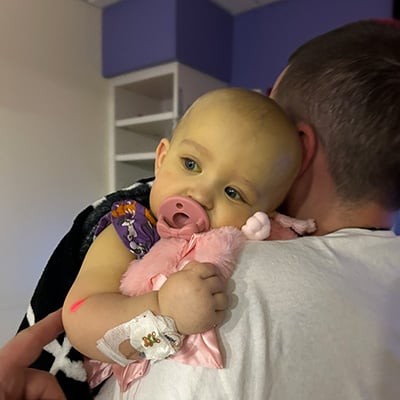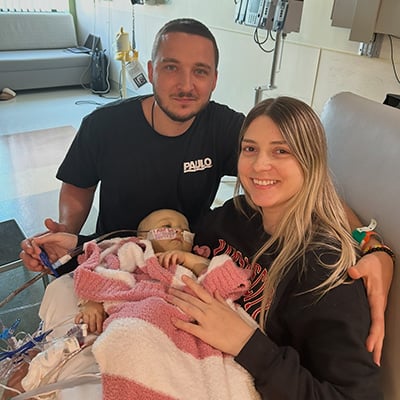Liver transplant: Olivia’s story
Meet Olivia

1-year-old Olivia was born with a rare, life-threatening disease. But with a liver transplant and support from her community, she’s thriving — and making people smile wherever she goes.
“Olivia is a very happy baby; she just lights up the room,” said her mom, Ciera. “She’s full of life and energy.”
When Olivia was born, she had some yellowing of her skin and whites of her eyes (jaundice). Ciera and Olivia’s dad, Preston, brought her to their local hospital for repeated lab draws in her first two weeks of life. Her bilirubin levels remained high, and a bili blanket (phototherapy to help Olivia’s body eliminate the bilirubin) didn’t help. There seemed to be a problem with Olivia’s liver.
Then at 3 weeks old, Olivia stopped wanting to eat. Ciera and Preston brought Olivia to the Liver Care Center at Childen's Mercy for a liver biopsy. They discovered Olivia was born with biliary atresia: Her bile ducts were blocked and couldn’t drain. Left untreated, biliary atresia causes severe liver damage and becomes life-threatening quickly.
A Kasai procedure buys time — but how much?
The day she turned 1 month old, Olivia had a Kasai procedure, a surgery that uses a loop of the bowel to route bile from the liver to the small intestines. A Kasai procedure, if done early, can help the liver function long-term. About 1/3 of patients with a Kasai procedure will go a decade before needing liver transplant. Another 1/3 will celebrate their 18th birthdays before they need a new liver. About 1/3 fail soon after the Kasai is done.
Olivia’s family and care team hoped for the best, and for around seven months, it seemed like the Kasai procedure was working. Olivia had multiple infections during that time, but her liver was able to drain bile.
But in June, her jaundice came back, and her stools turned white — signs that the Kasai had failed.
“A failed Kasai means that the connection is no longer effectively draining bile from the liver, which leads to rapid progression of liver disease and scar tissue development because bile is really toxic to the liver,” explained Jennifer Halma, MD, transplant hepatologist.
A donor liver in 9 days

The team started evaluating Olivia for a liver transplant immediately and listed her as soon as possible. They got the call only 9 days after she went on the list: There was a liver for Olivia.
“The range of emotions I felt on that phone call!” said Ciera. “Obviously, we were terrified but excited for the future we knew was coming for Olivia. We did not sleep that night!”
Transplant patients in Kansas City have some of the shortest wait times in the country, but this was fast even by Children’s Mercy standards. “We have the benefit of seeing offers from across the country, and our surgeons are willing to take offers for technically difficult transplant surgeries,” explained Dr. Halma. “Our team prioritizes listing kids and working them up the list as quickly as we can.”
Olivia’s surgery began in the early hours of August 11. Transplants are complex surgeries to begin with, and even more so when the patients are infants with very small vessels.
“We have a team here that’s doing a great job,” said Andrew Bonham, MD, FACS, Transplant Surgery Division Director, and Olivia’s surgeon. “Hopefully, we continue our trajectory of being able to offer transplants to kids early and get them done quickly — that’s the best thing for them.”
The transplant surgery went well, and her family was shocked at her new liver’s instant impact.
“When she came up from the OR, her color change was almost immediate,” said Ciera. “She was still slightly yellow, but we could already tell a difference. And when she would open her little eyes, they were white. They had been yellow for so long. I didn’t realize that it was going to happen so quickly.”
Olivia had some breathing issues post-surgery but was able to go off the ventilator in a couple days. She spent 2 weeks recovering at Children’s Mercy. She has come back in for dehydration and electrolyte issues but hasn’t had any significant complications since her surgery.
“The team here at Children’s Mercy is amazing, and we’re just so grateful for them,” said Ciera. “All of the nurses here on the 5th floor have truly been life-changing for us. They've made such a hard situation so much easier, and we will forever be grateful for them.”
The post-transplant road
“Post-transplant, we watch three main connections closely for complications: the artery, the vein and the biliary system,” said Dr. Halma. “For Olivia, we’ve been watching that biliary connection closely.”
“These tiny kids are having a massive operation,” explained Dr. Bonham. “You’re hooking up these tiny little bile ducts, and scar tissue forms over time on the inside. So we put a stent in to help hold that open as it heals; sometimes there’s not enough room early after transplant when everything’s swollen. Now, the bile is draining like it should.”
“Each patient is different,” said Dr. Halma. “Each post-transplant course is going to be unique to that patient, but that’s what we’re here for. We want to walk with families and reassure them that we’re here to help.”
“We don’t know what their road will look like post-transplant,” agreed Michelle Boswell Walden, MHA, RN, CPN, solid organ transplant coordinator. “We tell families you’re trading one disease process for another. We have to establish a good relationship early on: There’s a lot of trust we put into the families, and they have to put a lot of trust into us as well.”
"Soak up the moments”

Olivia will continue regular bloodwork, ultrasounds, biopsies and check-ins with her care team, but those appointments will taper off as her body adjusts to the new liver. Eventually, she’ll get lab work done every couple of months and come in for annual appointments.
“She’s like a brand-new baby after getting the new liver,” said Ciera. “She feels good, and we can tell.”
“She clearly feels better,” said Dr. Halma. “She’s making huge developmental leaps. She’s eating really well. She’s really taking off and thriving.”
Her team will miss getting to hang out with Olivia as often but is excited to see her get back to a more normal babyhood. “She’s always very cute and makes everyone smile,” said Michelle. “Everyone likes to see her!”
She’ll take immunosuppressants for the rest of her life — unless new advances come up with another way of helping her body accept the donated liver.
Liver transplant is a relatively new medical field, and clinicians are still discovering how long livers transplanted in very young children and infants can function. “We’re learning to take better care of and protect that graft for longer and longer,” said Dr. Halma.
For now, Olivia is getting the chance to be a doted-on little sister to her big sisters, Jaelinn, Bella and Paislee. Ciera’s advice for other families going through a transplant is to appreciate the time you have together, even during all the stress.
“Cherish every moment,” said Ciera. “I was so hyper-focused on labs and what the next problem was going to be that we weren’t really focusing on spending time together. If I have any advice it’s that: Soak up the moments.”